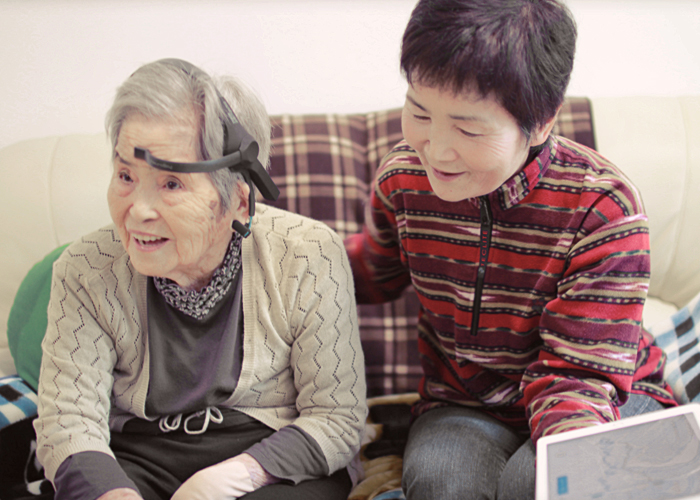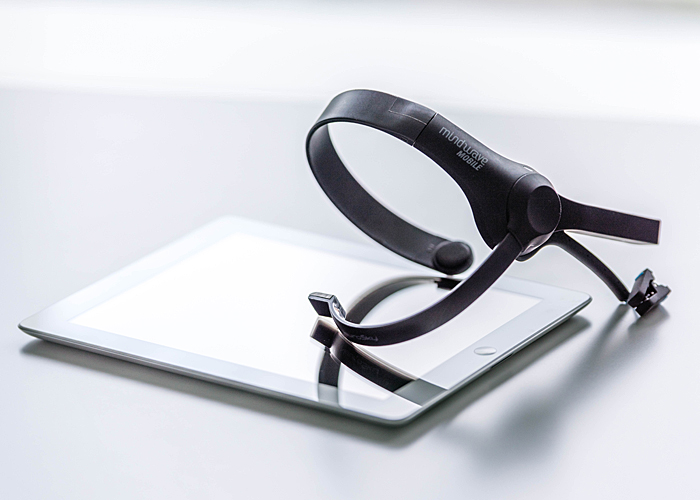Innovative technology for visualizing emotion in real-time and in the real-world
Published online 25 April 2019

Wearing the KANSEI Analyzer developed by Professor Mitsukura © Dentsu ScienceJam Inc.
Development of the Kansei Analyzer System
"I vividly remember seeing for the first time in 1997 how so-called electroencephalogram signals (EEG) of people changed dramatically depending on their state of mind," says Yasue Mitsukura, professor at the Department of System Design Engineering, Keio University. "These firsthand observations proved to be a major trigger for my research on quantifying emotion, or as it is called in Japanese 'kansei,' and this led to the development of the 'Kansei Analyzer System' that enables acquisition of EEG signals in real-time with a small electrode attached to the forehead and smart phone or tablet for signal analysis. It's a simple, portable, and versatile device for measuring EEG signals in a wide range of environments."
Importantly, the Kansei Analyzer System incorporates innovative noise reduction technology developed by Mitsukura and her colleagues that eliminates disruptive muscular noise, such as myoelectric signals from the blinking of the eyes, but without degradation of essential EEG components from the signal. Hence the Kansei Analyzer System enables subjects to move freely and naturally during signal acquisition, yielding accurate brain-computer information in real-time for both basic research and wide-ranging real-world applications.
Monitoring emotion, EEG-based human communication, and undertaking another doctorate
"Visualizing emotion was one of the reasons I started this research," explains Mitsukura. "I have used this system to measure stress levels and likes and dislikes of more than 8,000 people over 15 years. The portability and ease of use of the technology has enabled us to study emotion in many different environments ― measurements that are not possible using functional magnetic resonance imaging (fMRI) or other large systems used in hospital environments."
Mitsukura is also investigating the possibilities of using her system in healthcare and medicine. "Improving the quality of life of people with ALS (amyotrophic lateral sclerosis) is one of the most challenging projects that I am undertaking," says Mitsukura. "The delight and happiness that I have seen when the system allows families and ALS patients to communicate is truly inspiring and another motivation for continuing this research."
Mitsukura's passion for expanding the potential of the Kansei Analyzer System is reflected by her own efforts to learn more about medicine and medical science. "I am studying for a doctorate at the Keio University Medical School," says Mitsukura, who started to conduct research at the Graduate School of Medicine three years ago. "The focus of my research is to elucidate the effects of external stimuli, such as electrical shocks, for the treatment of depression and other neurological disorders." Currently, she is collecting medical evidence on the relationship between EEG signals and stimuli to the brain.
Recent research highlight: Focus on drowsiness
Accurate monitoring and analysis of drowsiness is important to alert motorists of danger and to improve efficiency in office work environments, as well as in educational settings for preparing engaging lectures for students.
Everyday experience shows that the level of drowsiness depends on the individual, time of day, and the surrounding environment. Effective research on the drowsiness of a large number of subjects necessitates inexpensive and portable equipment that enables the accurate detection and monitoring of drowsiness in real time, with minimal invasion, and ease of implementation and analysis of data.
In recent findings reported in the journal Sensors, Mitsukura and Mikito Ogino modeled the accuracy of EEG signals using a wide range of parameters and extraction methods, including power spectral density, autoregressive modeling, and multiscale entropy. Based on results that indicated that their model had a 72.7% accuracy, the team carried out experimental studies on 20 subjects using a single channel EEG device that was customized for low noise performance and the EEG signals were transmitted wirelessly to an iPad.
Analysis of 435 data sets showed a significant difference between a task of repetitive counting from 1 to 300 designed to induce drowsiness and a card sorting exercise that required high concentration.
The researchers foresee their system as being useful for practical studies with aims as diverse as measuring classroom mental engagement, evaluating movies, and managing office environments.

The Kansei Analyzer System © Dentsu ScienceJam Inc.
About the researcher

Yasue Mitsukura― Professor
Department of System Design Engineering, Faculty of Science and TechnologyYasue Mitsukura received a D.E. degree from the University of Tokushima in 2001. She has studied at the Graduate School of Medicine at Keio University since 2016. Previously, she was an Assistant Professor at the University of Tokushima and also lectured at Okayama University. In 2005 she took up the position of Associate Professor at the Tokyo University of Agriculture and Technology, moving to the Keio University Faculty of Science and Technology in 2011. From 2011-2017, Mitsukura was affiliated to the Department of System Design Engineering, and in 2018 she was promoted to Professor. Her research interests are in Bio-signal processing, EEG analysis, and image processing. She is a member of various associations, including IEEE, SICE, IEEJ, RISP, Auditory, AIJ, and IPS.
Reference
- Mikito Ogino1, Yasue Mitsukura2,1, Portable Drowsiness Detection through Use of a Prefrontal Single-Channel Electroencephalogram, Sensors, 18, 4477, (2018). | article